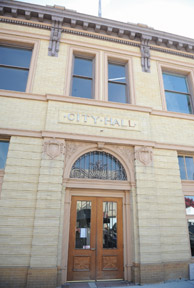Old City Hall isn’t looking quite so old these days due to first-floor renovations nearing completion, but top city officials have tabled the latest suggestion for the building – refurbishing the upper floor and making way for the engineering department to create a “one-stop shop” for development needs.
Development Services Director William Avera recommended council members approve a request for proposals from contractors to find out how much the second floor renovations might cost, with the thought of creating that one-stop shop for development services, as Avera called it at a recent council meeting.
His suggestion in January came as employees from planning and finance – where local residents pay their utility bills – were moving in to their mostly renovated office space at Old City Hall. It is a couple of doors down on Fifth Street from the current Hollister City Hall.
The first-floor project included basic tenant improvements and came at a cost of $84,000 – partly funded by the now-defunct redevelopment agency. Initially, it was intended to house just employees from the former RDA and those from finance, formerly operating out of the basement of Hollister City Hall, which created access issues that played into the move.
Officials in mid-2010 ended a long-running practice of donating Old City Hall as space to the county’s YMCA, which has since moved to the former Fortino’s building, and moved the RDA employees from their prior home at the Porter House and into the rent-free, city-owned location. The initial RDA move was intended to save money, as the agency before its move had been renting the Porter House on Monterey Street for $4,000 monthly.
As renovation work progressed at Old City Hall, city staff officials decided it was best to gain the most economy out of the space and also moved planning and building employees – from the relatively dilapidated Park Hill offices – there as well.
Avera’s latest recommendation for the second floor, though, likely would have exceeded six figures in cost. With talk of including such amenities as an elevator to create equal access – which officials said is not required in this case because of its small size and the area would be housing mid-management workers who don’t necessarily deal directly with the public – council members shied away from spending a huge sum on 2,700 square feet of office space.
Unlike the case with the first floor, the city would have to fund the second-floor improvements from the general fund, the primary source of employee compensation.
“Upstairs was going to cost a fortune,” Avera said in an interview with the Free Lance.
Mayor Ignacio Velazquez appeared reluctant to spend much money on the project, but did express the need to consider installing an elevator – for equal access – if the city does move ahead at some point.
The first floor already cost about $84,000. Avera said that money came from the former RDA and a utilities fund. Although it wasn’t a requirement for Avera to get council approval on the RFP – he emphasized at the meeting that other department heads normally go ahead without it – the elected leaders were not interested in finding out how much the second floor might cost. For now, they have essentially denied the request by tabling it.
Avera acknowledged it is unrealistic to spend a “half-million” dollars on such a small space, but said he does not have a next step planned for the engineering department, the only agency remaining on Park Hill.
As for the city property there, officials talked of possibly selling it or leasing it. He added there are a “couple schools of thought” – and said some people might want to keep the land set aside as park space.










